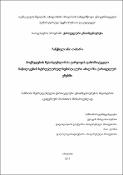Options
მოქმედების შესაძლებლობის უარყოფის გამომხატველი ნაწილაკების სტრუქტურულ-სემანტიკური ანალიზი ქართველურ ენებში
Date Issued
2019
Author(s)
Advisor(s)
Institution
Faculty
Abstract
The present paper deals with structural-semantic analysis of particles that express the
denial of the possibility of an action in Kartvelian languages. It aims to study the particles of this
type in these languages using the comparative method in order to reveal common and different
linguistic characteristics.
As known, in the Georgian language the denial of possibility is expressed by the negative
particles ver “cannot” that has a number of equivalents in Svan unlike Megrelian-Laz. This
difference in number conditioned the creation of this work. Since structural-semantic analysis
of negative particles based on the empirical material of Kartvelian languages is a complex issue,
we have decided to study only those particles that express the denial of the possibility of an
action in Kartvelian languages in terms of contrast and comparison.
Although at different times a number of scholars have worked on the issue of particles
expressing the denial of the possibility of an action and published their papers, our research
topic is relevant because it can fill the gap that is specifically related to the semantic
equivalence of the forms of the particle ver “cannot” in Kartvelian languages. The issues
analyzed in the work are important in terms of the comparative morphology of Kartvelian
languages, as well as to find the difficulties caused by different stylistic peculiarities during the
process of translation.
The work consists of the introduction, the main parts of the text and the conclusion. It is
accompanied by the table of contents, the list of the used literature and references. The
introduction gives the information about the goals of the research, the used methods and the
history of studying the issue. It tells about the topicality of the research and the tasks to achieve
the desirable results.
The theoretical part of the work is based on Georgian and foreign scientific papers
concerning the issue published at different times. The abundant empirical material based on a)
published texts, b) electronic sources and c) the material obtained during the field works in
Svaneti and Samegrelo in 2018-2019 has been processed.
denial of the possibility of an action in Kartvelian languages. It aims to study the particles of this
type in these languages using the comparative method in order to reveal common and different
linguistic characteristics.
As known, in the Georgian language the denial of possibility is expressed by the negative
particles ver “cannot” that has a number of equivalents in Svan unlike Megrelian-Laz. This
difference in number conditioned the creation of this work. Since structural-semantic analysis
of negative particles based on the empirical material of Kartvelian languages is a complex issue,
we have decided to study only those particles that express the denial of the possibility of an
action in Kartvelian languages in terms of contrast and comparison.
Although at different times a number of scholars have worked on the issue of particles
expressing the denial of the possibility of an action and published their papers, our research
topic is relevant because it can fill the gap that is specifically related to the semantic
equivalence of the forms of the particle ver “cannot” in Kartvelian languages. The issues
analyzed in the work are important in terms of the comparative morphology of Kartvelian
languages, as well as to find the difficulties caused by different stylistic peculiarities during the
process of translation.
The work consists of the introduction, the main parts of the text and the conclusion. It is
accompanied by the table of contents, the list of the used literature and references. The
introduction gives the information about the goals of the research, the used methods and the
history of studying the issue. It tells about the topicality of the research and the tasks to achieve
the desirable results.
The theoretical part of the work is based on Georgian and foreign scientific papers
concerning the issue published at different times. The abundant empirical material based on a)
published texts, b) electronic sources and c) the material obtained during the field works in
Svaneti and Samegrelo in 2018-2019 has been processed.
Degree Name
ქართველური ენათმეცნიერების მაგისტრი
Degree Discipline
ქართველური ენათმეცნიერება
File(s)
Loading...
Name
სამაგისტრო-ნაშრომი-თ.-ჩანქსელიანი-საბოლოო.pdf
Description
მოქმედების შესაძლებლობის უარყოფის გამომხატველი ნაწილაკების სტრუქტურულ-სემანტიკური ანალიზი ქართველურ ენებში
Size
1.35 MB
Format
Adobe PDF
Checksum
(MD5):2068994a509b669926906d505285f73a